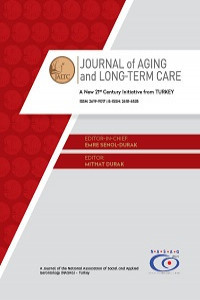The characteristics and life preferences of Turkish older adults
The characteristics and life preferences of Turkish older adults
The older adult population have been increasing around the World. The interaction of older adults with their physical and social environment is so important to promote age-friendly societies. In the present study, it is aimed to explore variables associated with satisfaction among older adults living at home and nursing home. Participants were composed of 1770 older adults living at home (N= 846) and nursing home (N=924). Results revealed that, regarding variables associated with home satisfaction, older adults having at least a hobby, participating in social activities, living with her/his spouse and living at a home belongs to her/himself or spouse had higher scores of satisfaction than their counterparts. Regarding variables associated with nursing home satisfaction, older adults referred to a nursing home by herself/himself, older adults having visitors (a family member or another person rather than a relative) at a nursing home, older adults visiting her/his family and older adults having at least a hobby had higher satisfaction scores than counterparts. Results were discussed with the literature and clinical implications.Key Practitioners MessageThe interaction of older adults with their physical and social environment is so important and identifying factors associated with satisfaction among the older adults living at home and nursing home are needed to assess on the basis of the ecological approach.Living with a spouse at home and owning the house in which (s)he lives are significantly related factors to home satisfaction of older adults.Participating in social activities and having hobbies are important for residence satisfaction among older adults either living at home or a nursing home.Having a visitor (family member or another person rather than a relative) at a nursing home increases residence satisfaction.
Keywords:
Older Adults Living at Home, Older Adults Living at Nursing Home, Home Satisfaction, Nursing Home Satisfaction, Living Place Participating in Social Activities, Hobbies,
___
- Cassarino, M., O’Sullivan, V., Kenny, R. A., & Setti, A. (2016). Environment and cognitive aging: A cross-sectional study of place of residence and cognitive performance in the Irish longitudinal study on aging. Neuropsychology, 30(5), 543.
- Durak, M. (2018). Late-Life Depression in the Older Adults Living in an Institution and at Home. Journal of Aging and Long-Term Care, 1(1), 5-17.
- Ellis, G., Whitehead, M. A., Robinson, D., O’Neill, D., & Langhorne, P. (2011). Comprehensive geriatric assessment for older adults admitted to hospital: meta-analysis of randomised controlled trials. BMJ, 343, d6553.
- Farber, Nicholas, et al.,( 2011). Aging in Place: A State Survey of Livability Policies and Practices. National Conference of State Legislatures and AARP, available at https://assets.aarp.org/rgcenter/ppi/livcom/aging-inplace-2011-full.pdf
- Hacihasanoglu, R., & Yildirim, A. (2009). Depression among the Elderly in Erzincan Nursing Home and Influential Factors. Turk Geriatri Dergisi-Turkish Journal of Geriatrics, 12(1), 25-30.
- Henning-Smith, C. (2016). Quality of life and psychological distress among older adults: The role of living arrangements. Journal of Applied Gerontology, 35(1), 39-61.
- Johnson Jr, J. H., & Appold, S. J. (2017). US older adults: Demographics, living arrangements, and barriers to aging in place. Kenan Institute.
- Kalaycıoğlu, S., Tol, U. U., Küçükkural, Ö., & Cengiz, K. (2003). Yaşlılar ve yaşlı yakınları açısından yaşam biçimi tercihleri (Lifestyle preferences for older adults and their relatives). Türkiye Bilimler Akademisi Raporları, Ankara
- Kasper, J. D., Freedman, V. A., Spillman, B. C., & Wolff, J. L. (2015). The disproportionate impact of dementia on family and unpaid caregiving to older adults. Health Affairs, 34(10), 1642-1649.
- Moreno, X., Sánchez, H., Huerta, M., Albala, C., & Márquez, C. (2016). Social representations of older adults among Chilean elders of three cities with different historical and sociodemographic background. Journal of Cross-cultural Gerontology, 31(2), 115-128.
- Okabayashi, H., Liang, J., Krause, N., Akiyama, H., & Sugisawa, H. (2004). Mental Health Among Older Adults in Japan: Do Sources of Social Support and Negative İnteraction Make a Difference? Social Science and Medicine, 59(11), 2259-2270.
- Sachs, G. A., Carter, R., Holtz, L. R., Smith, F., Stump, T. E., Tu, W., & Callahan, C. M. (2011). Cognitive Impairment: An Independent Predictor of Excess Mortality A Cohort Study. Annals Environment and Cognitive Ageing 33 of Internal Medicine, 155(5), 300–308.
- Shin, Y., Baik, S., Chung, E., Heo, S., & Ha, J. (2017). Impact of Hearing Loss on Social Contact Among Korean Older Adults: Place of Residence as Moderator. Innovation in Aging, 1(Suppl 1), 1174-1174.
- Soygür, H.(2000). Bakımevlerinde yaşlı bakımı ve psikolojik değerlendirme (Psychological assesment and caring older adults at nursing homes), Demans Dizisi, 1, 32-40.
- Télleza, A., Garcíaa, C. H., & Corral-Verdugo, V. (2015). Effect size, confdence intervals and statistical power in psychological research. Psychology in Russia: State of the Art, 8(3), 27-47.
- TSI (Turkish Statistical Institute) (2017). Older Adults Statistics, 2017 (İstatistiklerle yaşlılar, 2017). Türkiye İstatistik Kurumu Haber Bülteni, http://www.tuik. gov.tr/PreHaberBultenleri.do?id=27595
- Tufan, İ. (2003). Modernleşen Türkiye’de yaşlılık ve yaşlanmak: Yaşlanmanın sosyolojisi (Old Age and Aging in Modernizing Turkey: The Sociology of Aging). İstanbul: Anahtar Kitaplar.
- United Nations, Department of Economic and Social Affairs, Population Division (2017). Living Arrangements of Older Persons: A Report on an Expanded International Dataset (ST/ESA/SER.A/407).
- Wu, B., Yue, Y., & Mao, Z. (2015). Self-reported functional and general health status among older respondents in China: The impact of age, gender, and place of residence. Asia Pacific Journal of Public Health, 27(2), NP2220-NP2231.
- ISSN: 2619-9017
- Başlangıç: 2017
- Yayıncı: Ulusal Sosyal ve Uygulamalı Gerontoloji Derneği
Sayıdaki Diğer Makaleler
Reducing social isolation and improving the quality of life in older adults
Su Hsien CHANG, Ching-len YU, Mei-chen CHEN
The effect of GeroAtlas60+ Refresher University in preserving individual and community health
İsmail TUFAN, Sevnaz SAHİN, Melis OKTUG ZENGİN, Melike TAMER KOSE, Martin PALLAUF, Eva SCHULC
Community centers of local governments for retirees: The case of Istanbul
The characteristics and life preferences of Turkish older adults
